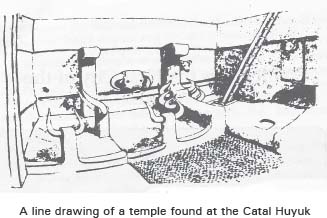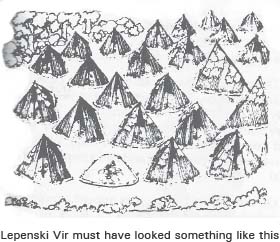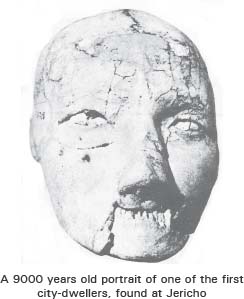
Till recently, it was believed that the first civilization was found in Sumeria. But not now. At Jericho, a 9,000-year-old wall has been excavated. At Catal Huyuk and Lepenski Vir also, various findings indicate the birth of a civilization.
The findings at these three places shattered the belief that the world’s first city originated 5,000 years ago in Sumeria. Now the question arises: whether developed cities came before Jericho and what happened between the gap of these three cities and Sumeria?
Few years back, it was believed that the world’s first city was built by Sumerians about 5,000 years ago in the area between river Tigris and Euphrates. It was believed that Ur, Vruk, Eridu, Lagash and Nipur were the wealthy cities of the Sumer, where civilization dawned. Before these cities, there was a void in pre-history.
However, recent discoveries made the historians to review their records. They had to announce that it was not Sumer where civilization took birth but even before it, there were cities with an advanced culture. These cities were Catal Huyuk, Jericho and Lepenski vir.
The advance in pre-historic research began after the Second World War. The carbon 14 dating technique enabled researchers to date ancient sites. They found out that man has been the only form of homosapiens on earth for the last 30,000 years. After this fact, the researchers were sure that civilization could not have started just 5,000 years ago, but it must be older than that and subsequently they discovered three cities which were much older than Sumer. However, with this discovery, they also faced another question – are these cities much older than Jericho, Catal Huyuk and Lepenski Vir?

The Bible mentions Jericho as the ‘city of palm trees’. It owes its existence to the fresh waters of the Aines Sultan spring or fountain of Elisha. They discovered that this city existed 9000 years ago, which is 4000 years ago before Sumer.
The biblical account of Jericho comes from the Book of Joshua. It says that Moses died before he could cross Jordon. His son Joshua guided the people of Israel out of the desert and across the river. After crossing the river, these people captured the first Canaanite city – Jericho. The entire city crumbled and the local population was murdered.
Archaeologists proceeded according to the above mentioned account. For nearly a century, they excavated in futility. Between 1952 and 1958, British archaeologists, Dr. Kaithleen Kenyon found some ancient crumbled walls. By carbon-14 dating, the researchers came to know the exact date of its existence. The dates indicated that the walls were built approximately in 7000 B.C. and according to the history, the people of Israel fought their battle sometime between 1400-150 B.C. So, it became clear that Joshua destroyed a city which was already at least 5,500 years old.

After Jericho’ discovery, another city was discovered by the British archaeologist, James Mellaart at Ankara in Turkey in 1961. This was Catal Huyuk. Following this discovery was the knowledge of Lepenski Vir, situated on the right bank of the Danube river in Yugoslavia. This city was discovered in 1965.
Archaeologists yet do not know how to place them in the general story of the evolution of the New Stone Age Culture. Catal Huyuk, particularly offer rich archaeological material for further research. It progressed as a city from 6250 to 5400 B.C. In 5400 B.C., it was finally abandoned. Unlike Jericho, Catal Huyak offer plenty of thoughts. It was at Catal Huyuk that archaeologists discovered a well-developed economy and religious and artistic life.
Contrary to Catal Huyuk, the remaining at Lepenski Vir suggests that there occurred a society of hunters and fishermen, belonging to the old Stone Age. The research has shown that this city was in the transitional stage. They were moving from encampments to houses.
Out of the three cities, the oldest one is the Jericho. It is an oasis in a valley at the northern end of the Dead Sea. While Catal Huyuk stands at an altitude of 3000 ft. in the middle of a fertile valley on the Carsamba Cay river, Lepenski Vir is situated in a small valley near Danube, in the middle of the Iron Gate Gorge.
The common feature among all the cities was water. In physical appearance, all the cities were not that big. Lepenski Vir was only 185 yards long and 55 yards wide. The population was not more than 200 to 300. Jericho covered about 10 acres of land and had population of about 2000 to 3000. While Catal Huyuk must have been 492 yards long and had a population of about 6000 to 10,000.
On the surface, these cities appear a molecule in front of Sumer which covered hundreds of acres of land and had thousands of inhabitants. Still these cities exhibit a great diversity in architectural design and planning.
The excavation at Jericho has revealed that these people lived in houses made up of curved mud bricks. The natives built rectangular houses which were built close to each other and had just one door as an opening.
At Catal Huyuk, there were no surrounding walls. The houses were joined with each other and the only way by which one could enter was through the roof. Hence, in their long history of 2000 years, we have no records of the city being ever sacked. The houses were built of rectangular clay bricks which were joined room was about 20 by 13 ft. and the other room was used as a granary.
The outline of Lepenski Vir was entirely different. The houses were built separate from each other. But they were all same and had a ten-like shape.
At Catal Huyuk and Jericho, we find evidence of many public buildings. While at Lepenski Vir, there are only four buildings which could have been temples. The excavations at Catal Huyuk has also revealed that women were respected and the mother goddess was worshipped. The diseases which often struck the inhabitants were malaria, pneumonia and arthritis. At Lepenski Vir, people followed strict traditions and were dependent on a community for a livelihood. But in Catal Huyuk, social life was more complex and social inequality persisted. This is evident from the varying sizes of buildings and differences in possessions and burial gifts.

In fact, Catal Huyuk achieved a level of technological advancement as they utilized both copper and lead metal art, the main researcher suggests “Catal Huyuk is nearly as great as that of developed civilization of the Early Bronze Age.”
There is no doubt that recent research as a fundamental force has made the historians rewrite the history of civilization. But they still do not know the answer to the question what—happened in the period between these cities and Sumer? How did the civilization progress between these two points? This is a missing link that is still unlocked.
